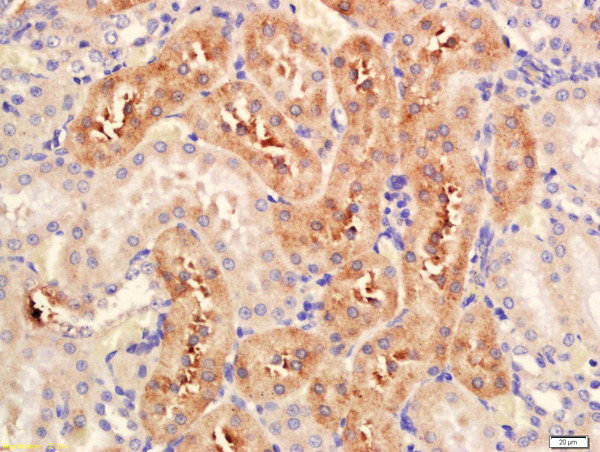![IHC-P analysis of liver carcinoma tissue using GTX83567 Serine racemase antibody [9E8]. Antigen retrieval : Heat-induced epitope retrieval by 10mM citrate buffer, pH6.0, 100oC for 10min. Dilution : 1:50 IHC-P analysis of liver carcinoma tissue using GTX83567 Serine racemase antibody [9E8]. Antigen retrieval : Heat-induced epitope retrieval by 10mM citrate buffer, pH6.0, 100oC for 10min. Dilution : 1:50](https://www.genetex.com/upload/website/prouct_img/normal/GTX83567/GTX83567_1618_IHC-P_w_23061420_383.webp)
IHC-P analysis of liver carcinoma tissue using GTX83567 Serine racemase antibody [9E8]. Antigen retrieval : Heat-induced epitope retrieval by 10mM citrate buffer, pH6.0, 100oC for 10min. Dilution : 1:50
Serine racemase antibody [9E8]
GTX83567
ApplicationsFlow Cytometry, ImmunoFluorescence, Western Blot, ImmunoCytoChemistry, ImmunoHistoChemistry, ImmunoHistoChemistry Frozen, ImmunoHistoChemistry Paraffin
Product group Antibodies
TargetSRR
Overview
- SupplierGeneTex
- Product NameSerine racemase antibody [9E8]
- Delivery Days Customer9
- Application Supplier NoteWB: 1:200. IHC-P: 1:100-1:200. *Optimal dilutions/concentrations should be determined by the researcher.Not tested in other applications.
- ApplicationsFlow Cytometry, ImmunoFluorescence, Western Blot, ImmunoCytoChemistry, ImmunoHistoChemistry, ImmunoHistoChemistry Frozen, ImmunoHistoChemistry Paraffin
- CertificationResearch Use Only
- ClonalityMonoclonal
- Concentration0.86 mg/ml
- ConjugateUnconjugated
- Gene ID63826
- Target nameSRR
- Target descriptionserine racemase
- Target synonymsILV1, ISO1, serine racemase, D-serine ammonia-lyase, D-serine dehydratase, L-serine ammonia-lyase, L-serine dehydratase
- HostMouse
- IsotypeIgG1
- Protein IDQ9GZT4
- Protein NameSerine racemase
- Scientific DescriptionCatalyzes the synthesis of D-serine from L-serine.
- Storage Instruction-20°C or -80°C,2°C to 8°C
- UNSPSC12352203
References
- Beesley S, Sullenberger T, Crotty K, et al. D-serine mitigates cell loss associated with temporal lobe epilepsy. Nat Commun. 2020,11(1):4966. doi: 10.1038/s41467-020-18757-2Read this paper

![WB analysis of various cell lines using GTX83567 Serine racemase antibody [9E8]. Loading : 10 ug per lane Dilution : 1:2000 WB analysis of various cell lines using GTX83567 Serine racemase antibody [9E8]. Loading : 10 ug per lane Dilution : 1:2000](https://www.genetex.com/upload/website/prouct_img/normal/GTX83567/GTX83567_3595_WB_w_23061420_222.webp)
![WB analysis of HEK293T cells transfected with Serine racemase plasmid (Right) or empty vector (Left) for 48 hrs using GTX83567 Serine racemase antibody [9E8]. Loading : 5 ug per lane WB analysis of HEK293T cells transfected with Serine racemase plasmid (Right) or empty vector (Left) for 48 hrs using GTX83567 Serine racemase antibody [9E8]. Loading : 5 ug per lane](https://www.genetex.com/upload/website/prouct_img/normal/GTX83567/GTX83567_3739_WB_w_23061420_259.webp)
![ICC/IF analysis of COS7 cells transiently transfected with Serine racemase plasmid using GTX83567 Serine racemase antibody [9E8]. ICC/IF analysis of COS7 cells transiently transfected with Serine racemase plasmid using GTX83567 Serine racemase antibody [9E8].](https://www.genetex.com/upload/website/prouct_img/normal/GTX83567/GTX83567_719_ICCIF_w_23061420_995.webp)
![ICC/IF analysis of HepG2 cells using GTX83567 Serine racemase antibody [9E8]. ICC/IF analysis of HepG2 cells using GTX83567 Serine racemase antibody [9E8].](https://www.genetex.com/upload/website/prouct_img/normal/GTX83567/GTX83567_720_ICCIF_w_23061420_942.webp)
![FACS analysis of HEK293T cells transfected with either Serine racemase plasmid(Red) or empty vector control plasmid(Blue) using GTX83567 Serine racemase antibody [9E8]. FACS analysis of HEK293T cells transfected with either Serine racemase plasmid(Red) or empty vector control plasmid(Blue) using GTX83567 Serine racemase antibody [9E8].](https://www.genetex.com/upload/website/prouct_img/normal/GTX83567/GTX83567_73_FACS_w_23061420_707.webp)




![IHC-P analysis of liver carcinoma tissue using GTX83568 Serine racemase antibody [7E8]. Antigen retrieval : Heat-induced epitope retrieval by 10mM citrate buffer, pH6.0, 100oC for 10min. Dilution : 1:50](https://www.genetex.com/upload/website/prouct_img/normal/GTX83568/GTX83568_1619_IHC-P_w_23061420_536.webp)

